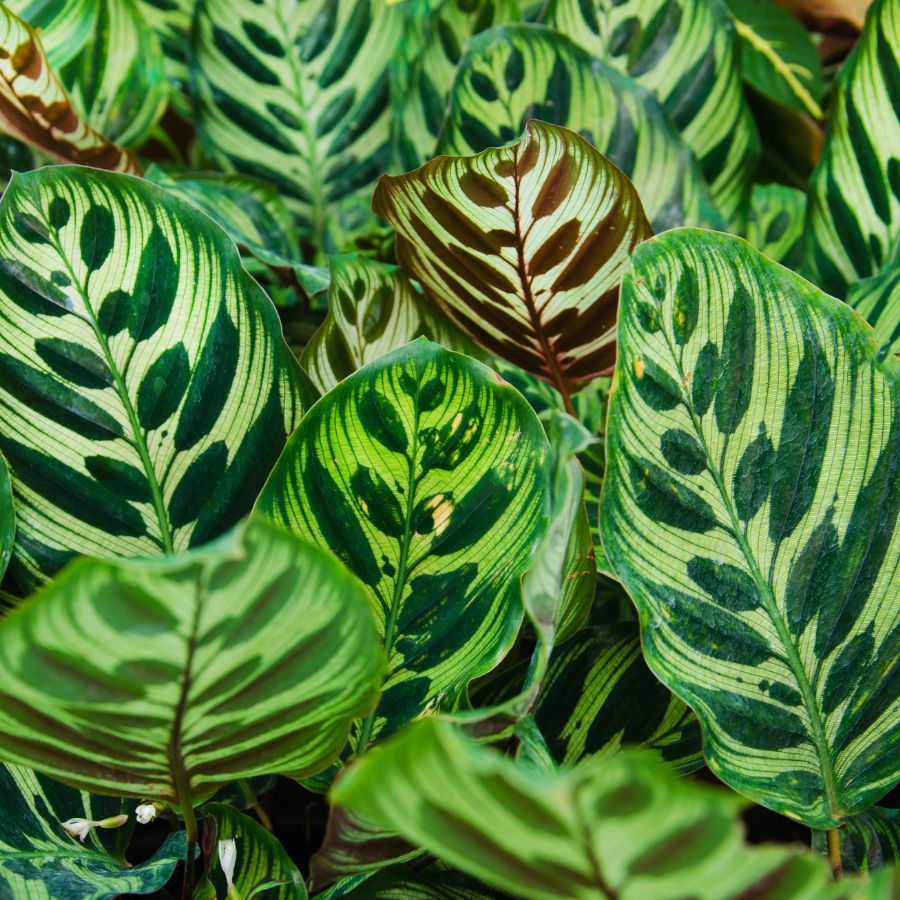Calathea
Calathea care can be difficult only because the plants require specific conditions and aren’t particularly hard to neglect. They will thrive indoors if you can mimic a tropical climate. They are prized for their striking foliage.
Light
Calatheas prefer filtered light or shade. Keep your calathea out of direct sun, as too much light can burn the leaves and cause their vibrant patterns to fade.
When growing them indoors, indirect sun from an east-, south-, or west-facing window is perfect. It is helpful to rotate your plant every few weeks, so sun hits it evenly. You might notice the leaves of your calathea moving throughout the day, folding up at night and opening wider in the morning. This is so the plant can maximize sun absorbency.
Soil
Calatheas prefer a peaty potting mixture that is lightweight and airy.(African violet soil mixture works well).
Water
Water regularly to maintain consistently moist (but not soggy) soil. Calatheas like a lot of water, but they don’t want to be waterlogged.
Fertilizer
Fertilize your calathea once a month with a liquid balanced fertilizer at half strength throughout the spring, summer, and fall. Hold off on fertilizer in the winter months when the plant naturally grows less.
Growth Calatheas are highly sensitive to chilly temperatures and grow best when kept in a warm, humid environment. Only growing to about 2 feet tall and wide, calatheas can fit in almost any space.
Pruning
Calathea plants don’t require regular pruning. The only maintenance you’ll have to do is to trim off brown, wilted leaves as they naturally die off.
Potting and Repotting Calathea
Make sure the container has ample drainage holes. An unglazed clay pot can be a good material to allow excess soil moisture to evaporate through its walls if you have a tendency to overwater.
It’s best to stick with one calathea plant per pot, so the roots don’t become overcrowded. Plan to repot every few years in a container that is 1 to 2 inches larger in diameter. Calathea plants that are root-bound can become weak and unhealthy, as they won’t be able to efficiently take up moisture and nutrients.
Repotting is best done in spring or early summer during the plant’s active growing season. Water your calathea well a day or two before repotting to lessen the stress on the plant. Gently ease the rootball out of the old pot, keeping the roots as intact as possible, and plant it at the same depth in the new pot, filling around it with fresh potting mix.
Potential Problems With Calathea
When grown in the environment they like, calatheas have few issues. But when conditions are even slightly off, some problems can arise.
Browning Tips
If you notice the edges of your calathea’s leaves are browning or withering, that’s a sure sign you need to up your watering
Leaves Turning Yellow
Calatheas are surprisingly picky when it comes to the type of water they receive. They are sensitive to several minerals typically found in most tap water, which can cause their leaves to yellow. To avoid this, water your calathea with filtered water, rainwater, or tap water that has sat out overnight so that any chlorine or fluoride has time to evaporate.
Types of Calathea- there are over 50 varieties, some of the most commonly available are
- Calathea orbifolia
- Calathea makoyana/peacock
- Calathea ornata/Pinstripe
- Zebrina
- Lancifolia/rattlesnake
- Leopardina
- Ruffles
- Pilosa
- Burle-marxii
- Royal Standard


